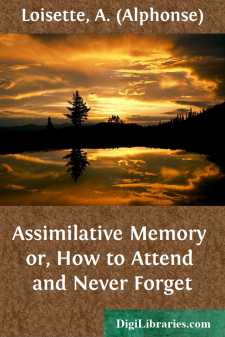Categories
- Antiques & Collectibles 13
- Architecture 36
- Art 48
- Bibles 22
- Biography & Autobiography 813
- Body, Mind & Spirit 142
- Business & Economics 28
- Children's Books 17
- Children's Fiction 14
- Computers 4
- Cooking 94
- Crafts & Hobbies 4
- Drama 346
- Education 46
- Family & Relationships 57
- Fiction 11829
- Games 19
- Gardening 17
- Health & Fitness 34
- History 1377
- House & Home 1
- Humor 147
- Juvenile Fiction 1873
- Juvenile Nonfiction 202
- Language Arts & Disciplines 88
- Law 16
- Literary Collections 686
- Literary Criticism 179
- Mathematics 13
- Medical 41
- Music 40
- Nature 179
- Non-Classifiable 1768
- Performing Arts 7
- Periodicals 1453
- Philosophy 64
- Photography 2
- Poetry 896
- Political Science 203
- Psychology 42
- Reference 154
- Religion 513
- Science 126
- Self-Help 84
- Social Science 81
- Sports & Recreation 34
- Study Aids 3
- Technology & Engineering 59
- Transportation 23
- Travel 463
- True Crime 29
Assimilative Memory or, How to Attend and Never Forget
Categories:
Description:
Excerpt
FUNDAMENTAL PRINCIPLES.
What is the basic principle of my system? It is, Learn by Thinking. What is Attention? It is the will directing the activity of the intellect into some particular channel and keeping it there. It is the opposite of mind-wandering. What is thinking? It consists in finding relations between the objects of thought with an immediate awareness of those relations.
What is the Sensuous memory? It is association through the eye or ear of a succession of sights or sounds without any reflection or consideration of the units of the succession, or what they stand for, or represent. It is learning by rote—mere repetition—mere brainless or thoughtless repetition—a mode of learning that is not lasting—and always causes or promotes mind-wandering.
What is Assimilative memory? It is the habit of so receiving and absorbing impressions or ideas that they or their representatives shall be ready for revival or recall whenever wanted. It is learning through relations—by thinking—from grasping the ideas or thoughts—the meaning and the comprehension of the subject matter. This mode of learning promotes attention and prevents mind-wandering.
What are the two stages of the Memory? Let me illustrate: Last week, month, or year you saw a military procession pass along the streets. Note how your mind was affected. Into your eyes went impressions as to the number composing the procession, their style of costume or dress, the orderliness or otherwise of their march, the shape and form of the musical instruments in the hands of the band, and the appearance of the officer in charge on horseback. Into your ears went impressions of the sound of the tramp and tread of the soldiers, the tune played by the band, and any commands uttered by the officer. These impressions commingling in your brain made up your experience of the passing of the procession—your first and only experience of it at that time. I call this the First Stage of the Memory—the stage of the First Impression, which is always the precursor of the Second Stage.
What is the Second Stage of the Memory? This moment you recall what? Not the procession itself; for it is no longer in existence. You saw and heard it then, but you do not see or hear it now. You only recall the impression left upon your mind by the procession. A ray of Consciousness is passed over that impression and you re-read it, you re-awaken the record. This is the Second Stage of the Memory—the revival of the previous experience—the recall to consciousness of the First Impression. The First Impression with no power to revive it afterward, gives no memory. However great the power of Revival, there is no memory unless there was a First Impression. There are three conditions of memory—(1) Impression. (2) Its Preservation. (3) Its Revival. We are mainly concerned here with the Impression and its Revival.
There are (five) kinds of memories rising from the natural aptitudes of different individuals—(1) First Impressions are apt to be feeble and the power to revive them weak—a poor memory. (2) First Impressions are usually weak but the power to revive them is strong—still a poor memory. (3) First Impressions are usually vivid but the power to revive them is weak—a poor memory. (4) First Impressions on all subjects are strong and the power to revive them is strong—a first-class memory. (5) First Impressions in some particulars are very strong and the reviving power in regard to them is very strong—a good memory for these particulars, or a memory good for mathematics, or music, or faces, or reciting, or languages, , but usually weak in most other respects.
THREE LAWS OF MEMORY OR OF THINKING.
The first and principal thing the pupil requires to do in this lesson after learning the definition of the following Three Laws—is to be able to clearly understand the examples under each Law, and whether they verify or illustrate that Law.
- indicates that there is an overlapping of meaning between two words, or that there is a prominent idea or sound that belongs to both alike, or that a similar fact or property belongs to two events or things as, to enumerate a few classes:—
- —(Earth, Poles.) (Ship, Rudder.) (Forest, Trees.) (Air, Oxygen.) (House, Parlor.) (Clock, Pendulum.) (Knife, Blade.) (India, Punjab.) (14, 7.) (24, 12.)
- —(Animal, Man.) (Plant, Thyme.) (Fish, Salmon.) (Tree, Oak.) (Game, Pheasant.) (Dog, Retriever.) (Universal Evolution, Natural Selection.) (Silver Lining, Relief of Lucknow.) (Empress Queen, Victoria.) (Money, Cash.)
- —[The same Quality appears both in the Adjective and in the Substantive.]—(Dough, Soft.) (Empty, Drum.) (Lion, Strong.) (Eagle, Swift.) (Courage, Hero.) (Glass, Smoothness.) (Gold, Ductility.) (Sunshine, Light.) (Fire, Warmth.)
- —(Emperor, Empty.) (Salvation, Salamander.) (Hallelujah, Hallucination.) (Cat, Catastrophe.) (Top, Topsy.) [Inclusion by sound is not punning.]
- embraces cases not found in either of the foregoing classes, but where there is something in common between the pairs, as (Church, Temple.) (Pocket, Black Hole.)
- means Antithesis....






